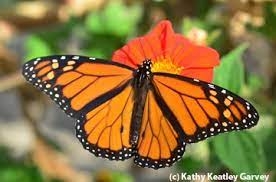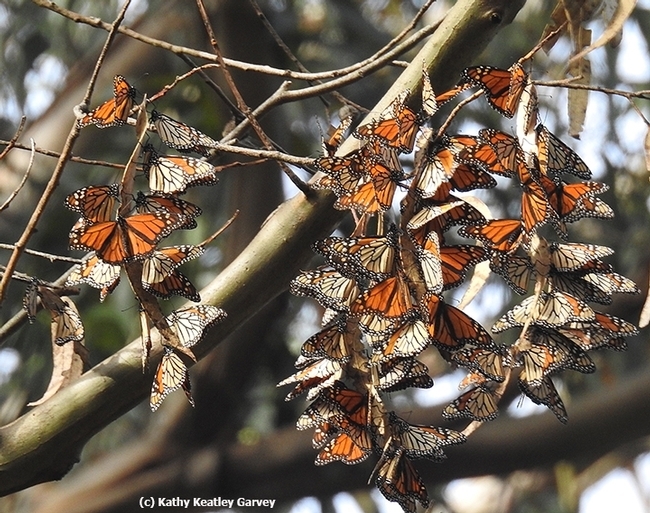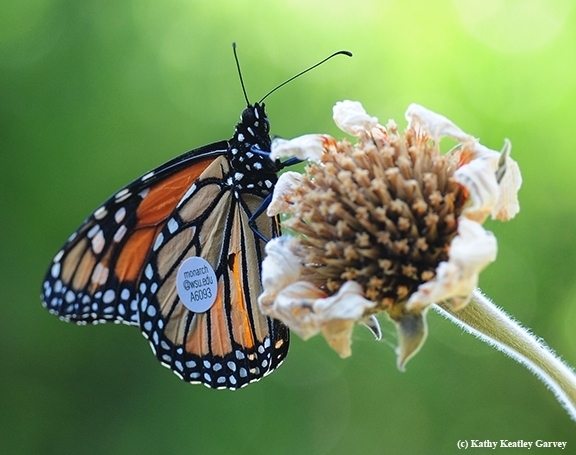- Author: Kathy Keatley Garvey

Entomologist and monarch scientist David James of Washington State University posted this yesterday on his Facebook page, Monarch Butterflies in the Pacific Northwest:
"Insect populations are well known for large annual fluctuations in size. However, rarely do these fluctuations occur on the scale currently being seen in western monarchs. From less than 2,000 monarchs counted in 2020, we currently have more than an estimated 200,000 at the overwintering sites! A 100-fold increase! This is staggering! However, it is less of a surprise to me than many others. In March 2021, I published a commentary paper titled Western North American Monarchs: Spiraling into Oblivion or Adapting to a Changing Environment? (Animal Migration journal). I suggested the latter was the case and stated: ‘the adaptability of the monarch butterfly will allow it to persist in a changed environment'. I based this on more than 40 years study of monarch populations, particularly research I did, published in peer-reviewed journals, that showed monarchs in Australia (they arrived in 1870 by island-hopping across the Pacific) had adapted physiologically to Australian conditions. I think we are seeing this monarch ‘power' now. They are trying different things in terms of life strategies and inevitably there will be failures and successes. This is how insects adapt and evolve. We will see more ups and downs in the future, but I have seen how adaptive and resilient the monarch is. This isn't to say we shouldn't help the monarch. We should and we are, primarily by creating habitat and reducing pesticide use. We can work with the adaptable and resilient monarch and ultimately turn 200,000 into 2,000,000!"
Mona Miller, who administers the popular Facebook page, Creating Habitat For Butterflies, Moths, & Pollinators, responded to the WSU post: "Monarch are resilient insects, they have so many strategies to increase their population, but they do have their limits. We must stop pulling out tropical milkweed and cutting it back. Washing off all milkweed should suffice to clean off the OE spores. I emailed several scientists, no one could tell me that OE (Ophryocystis elektroscirrha is a protozoan parasite) has any way to attach to milkweed leaves other than getting caught in the hairs. Tropical milkweed has smooth leaves. Tropical milkweed has been in California since 1909, that is over 100 years. Totally eradicating tropical milkweed just like totally eradicating all the eucalyptus trees would have a detrimental effect on the Monarch population, perhaps it already has." (Note: both eucalyptus trees and tropical milkweed are non-natives.)
"Do plant native milkweeds and nectar sources," she advocates. "If you don't have land, plant these plants in containers. Any habitat is critical to help feed the pollinators including Monarch butterflies."
In response to a post that "Tropical milkweed and eucalyptus trees are not native to Ca regardless of how long they have been here," Miller pointed out: "There are many plants growing in California that are not native to California. The fact is that the Monarch butterflies are using both of these plants. If these plants are immediately eradicated it would be compromising shelter, nectar, and host plants for the Monarch butterfly. During the winter both are blooming and provide nectar. Cutting back tropical milkweed when it has caterpillars in the winter should not be done. How is the Monarch butterfly going to evolve to adapt to the weather without tropical milkweed? Like I said, just wash off all milkweeds to clean off the OE. Due to changes in weather, there are also some native milkweeds that are not dying back in the winter. We can help the Monarch butterflies adapt or we can pull the rug out from under them by continuing to eradicate the plants that they need for winter survival."
Another point: Monarchs aren't native, either. Read Lincoln Brower's "Understanding and Misunderstanding the Migration of the Monarch Butterfly (Nymphalidae) in North America: 1857-1995" (Journal of the Lepidopterists' Society 49(4), 1995,304-385.) It begins: "Since 1857, amateurs and professionals have woven a rich tapestry of biological information about the monarch butterfly's migration in North America. Huge fall migrations were first noted in the midwestern states, and then eastward to the Atlantic coast. Plowing of the prairies together with clearing of the eastern forests promoted the growth of the milkweed, Asclepias syriaca, and probably extended the center of breeding from the prairie states into the Great Lakes region. Discovery of overwintering sites along the California coast in 1881 and the failure to find consistent overwintering areas in the east confused everyone for nearly a century. Where did the millions of monarchs migrating southward east of the Rocky Mountains spend the winter before their spring remigration back in to the eastern United States and southern Canada? Through most of the 20th century, the Gulf coast was assumed to be the wintering area, but recent studies rule this out because adults lack sufficient freezing resistance to survive the recurrent severe frosts."
Art Shapiro, UC Davis distinguished professor of evolution and ecology who maintains a research website at http://butterfly.ucdavis.edu/, weighed in on the issue today in an email about the monarch population increase: "We do not know where they are coming from. This merely goes to show (1) how spotty our coverage is. (2) how little we understand about life-history plasticity in this species. (3) that most of the received wisdom about the decline and its causes is bunk."
Shapiro has monitored butterfly population trends on a transect across central California since 1972. The 10 sites stretch from the Sacramento River Delta through the Sacramento Valley and Sierra Nevada mountains to the high desert of the Western Great Basin. The largest and oldest database in North America, it was recently cited by British conservation biologist Chris Thomas in a worldwide study of insect biomass.
We remember when Shapiro observed an way-early monarch in Sacramento on Jan. 29, 2020. Later in the afternoon, he heard monarch scientist Elizabeth Crone, professor of Tufts University, present a UC Davis Department of Entomology and Nematology seminar on the decline of Western monarchs.
In her seminar, Crone expressed concern about the lack of scientific knowledge about monarchs, especially when they emerge from their overwintering sites along coastal California, usually around February, and head inland. Said Crone: "We don't know what they're doing between February and when milkweeds break ground later in spring."
There is so much we do not know about monarchs...
UC Davis-affiliated resource, published Nov. 17, 2020 in Proceedings of the National Academy of Sciences (PNAS):
"Two Centuries of Monarch Butterfly Collections Reveal Contrasting Effects of Range Expansion and Migration Loss"





Remember, all milkweeds collect OE (Ophryocystis elektroscirrha) spores. Plants don't make their own OE spores. Monarch adults visiting the plants drop the spores onto the plants. OE is more prevalent in the fall. There are evergreen milkweeds in southern states in late fall and winter that also collect OE spores. Please don't bash tropical milkweeds. It is a native to Mexico and Central Mexico, where it is used year round. Tropical is also used by migrating Monarchs in the spring and fall. Monarchs migrating through Mexico in the spring and fall lay eggs on tropical milkweeds. I wonder if their offspring will continue the journey north.
"Tropical Milkweed and the injurious effects of well-meaning people" by Jeffrey Glassberg, President of the North American Butterfly Association http://nababutterfly.com/wordpress/wp-content/uploads/2015/04/Tropical-Milkweed.pdf
Frankly pulling out tropical milkweed when Monarchs need milkweed is absolutely insane. Milkweed can be sprayed with water to wash off OE spores. I contacted several scientists and asked them if OE had any way to attached to the plants, only one had an answer: perhaps the tiny spores can get caught in the hairs. Tropical milkweed has smooth leaves. All milkweeds should be washed prior to feeding to Monarch caterpillars. Tropical milkweeds don't have hairy leaves to catch and hold spores. Or you can cut it back and allow it to regrow. Cutting back is best done by only cutting back one third of your plants at one time that way you will still have milkweed available. Do not cut back milkweed, if there are eggs or caterpillars present because this will deprive them of food. Once cut back, cover with garden cloth (Information on using Light Weight Garden Fabric https://www.gardeners.com/how-to/row-covers/5111.html) to allow it to regrow. If left uncovered, Monarchs will still visit and lay on stems of milkweed.
Cutting back tropical milkweed is not recommended in south Florida where there are residential non-migratory monarch populations. See info on the south Florida group about not cutting back tropical south of Orlando: https://nickiebodv.blogspot.com/2015/03/welcome.html
Cutting back tropical milkweed in late fall to winter in some areas gets rid of any OE spores and promotes new clean growth. It isn't the plant causing the OE, it is the butterflies that have the OE dropping the spores on the plants. Those OE spores can also drop on nectar and other milkweed host plants. Research has shown that Monarchs that eat tropical milkweed plants are more resistant to OE. "Patterns of Host-Parasite Adaptation in Three Populations of Monarch Butterflies Infected with a Naturally Occurring Protozoan Disease: Virulence, Resistance, and Tolerance" http://www.jstor.org/stable/10.1086/673442#mobileBookmark
It has also been shown that parents eating tropical milkweed gain a resistance to OE and their offspring are even more resistant. Monarchs that eat tropical milkweed plants also produce less tachinid flies. And, are more noxious to predators due to the higher level of toxins in tropical milkweed. "Trans?generational parasite protection associated with paternal diet" https://besjournals.onlinelibrary.wiley.com/doi/full/10.1111/1365-2656.12289
Plant natives, but don't give tropical milkweed a bad rap. I find that tropical and african milkweeds are very medicinal for Monarchs. They actually prefer them. If given a choice between natives and tropicals, Monarchs usually choose the more toxic tropical varieties. They will usually lay on swamp over common. Swamp is more toxic. They will usually choose common over butterfly weed. Common is more toxic. “How butterflies self-medicate” https://www.ted.com/talks/jaap_de_roode_how_butterflies_self_medicate/transcript?language=en#t-17545
First identified in the 1960s, this is the first research that was published on “Ophryocystis elektroscirrha sp. n., a Neogregarine Pathogen of the Monarch Butterfly Danaus plexippus (L.) and the Florida Queen Butterfly D. gilippus berenice Cramer”R. E. McLAUGHLIN and JUDITH MYERShttps://www.researchgate.net/profile/Judith-Myers-3/publication/229980142_Ophryocystis_elektroscirrha_sp_n_a_Neogregarine_Pathogen_of_the_Monarch_Butterfly_Danaus_plexippus_L_and_the_Florida_Queen_Butterfly_D_gilippus_berenice_Cramer1/links/5f99e497299bf1b53e4ed39e/Ophryocystis-elektroscirrha-sp-n-a-Neogregarine-Pathogen-of-the-Monarch-Butterfly-Danaus-plexippus-L-and-the-Florida-Queen-Butterfly-D-gilippus-berenice-Cramer1.pdf?origin=publication_detail
“Host Diet Affects the Morphology of Monarch Butterfly Parasites”Kevin Hoang, Leiling Tao, Mark D. Hunter, Jacobus C. de Roode” Abstract
Understanding host–parasite interactions is essential for ecological research, wildlife conservation, and health management. While most studies focus on numerical traits of parasite groups, such as changes in parasite load, less focus is placed on the traits of individual parasites such as parasite size and shape (parasite morphology). Parasite morphology has significant effects on parasite fitness such as initial colonization of hosts, avoidance of host immune defenses, and the availability of resources for parasite replication. As such, understanding factors that affect parasite morphology is important in predicting the consequences of host–parasite interactions. Here, we studied how host diet affected the spore morphology of a protozoan parasite (Ophryocystis elektroscirrha), a specialist parasite of the monarch butterfly (Danaus plexippus). We found that different host plant species (milkweeds; Asclepias spp.) significantly affected parasite spore size. Previous studies have found that cardenolides, secondary chemicals in host plants of monarchs, can reduce parasite loads and increase the lifespan of infected butterflies. Adding to this benefit of high cardenolide milkweeds, we found that infected monarchs reared on milkweeds of higher cardenolide concentrations yielded smaller parasites, a potentially hidden characteristic of cardenolides that may have important implications for monarch–parasite interactions.” https://bioone.org/journals/journal-of-parasitology/volume-103/issue-3/16-142/Host-Diet-Affects-the-Morphology-of-Monarch-Butterfly-Parasites/10.1645/16-142.full
I don’t know why, but I have found African Milkweed, Asclepias physocarpa to be very medicinal. I did a little experiment to prove this. I introduced sickly caterpillars to the plant. I kept them enclosed in organza bags outside. Monarch caterpillars that weren't thriving were able to grow successfully and pupate after they were introduced to the african milkweed, Asclepias physocarpa. This post has the details: https://www.facebook.com/mona.miller.73/posts/10216149671373840
“Milkweeds, monarch butterflies and the ecological significance of cardenolides” Stephen B. Malcolm https://www.researchgate.net/profile/Stephen-Malcolm/publication/226101016_Milkweeds_monarch_butterflies_and_the_ecological_significance_of_cardenolides/links/5b9ff04645851574f7d25661/Milkweeds-monarch-butterflies-and-the-ecological-significance-of-cardenolides.pdf?origin=publication_detail (scroll down to read on this link). I did find in this article that tropical milkweed, Asclepias curassavica, has the highest level of toxins.
"Pollinator Conservation Seed Mixes"
Please scroll down on this website: https://www.xerces.org/pollinator-conservation/pollinator-conservation-seed-mixes
“…this seed mix has been formulated based on field trials and monitoring conducted by the Xerces Society and other conservation partners. This mix contains native and non-native forbs, brassicas and legumes. It consists of early-maturing annual species,..”
Monarch Watch also recommends some non natives in their plant lists for butterflies: https://www.monarchwatch.org/garden/plant-lists.html
Those include “Butterfly Bush, Buddleia davidii Flutterby series – only plant male sterile varieties shrub; non-sterile varieties can be invasive.” And “Tropical milkweed, Asclepias curassavica” for the Northeast: https://www.monarchwatch.org/garden/plant-list-monarchwatch.pdf
They also have native and non native recommendations for Texas: https://www.monarchwatch.org/garden/plant-list-tx-monarchwatch.pdf
Why are these groups recommending a combination of natives and non natives? It is because experts who know the needs of butterflies and other pollinators recommend these plants to keep gardens blooming. Yes, our gardens should be a majority of natives, but that doesn’t mean that we exclude all exotic plants. Do you know what I am noticing this year with the horrible heat and drought, native plants aren’t coping. They are zooming through their blooming period, while many exotics are still blooming and will continue blooming. I think our priority should be to keep our pollinators fed. I see myths pushed that exotic plant nectar is not good quality or the plants aren’t host plants. Well, our native insects are evolving to use these exotic plants because some of our natives are either blooming too early or too late for them to use as food. These are my observations.